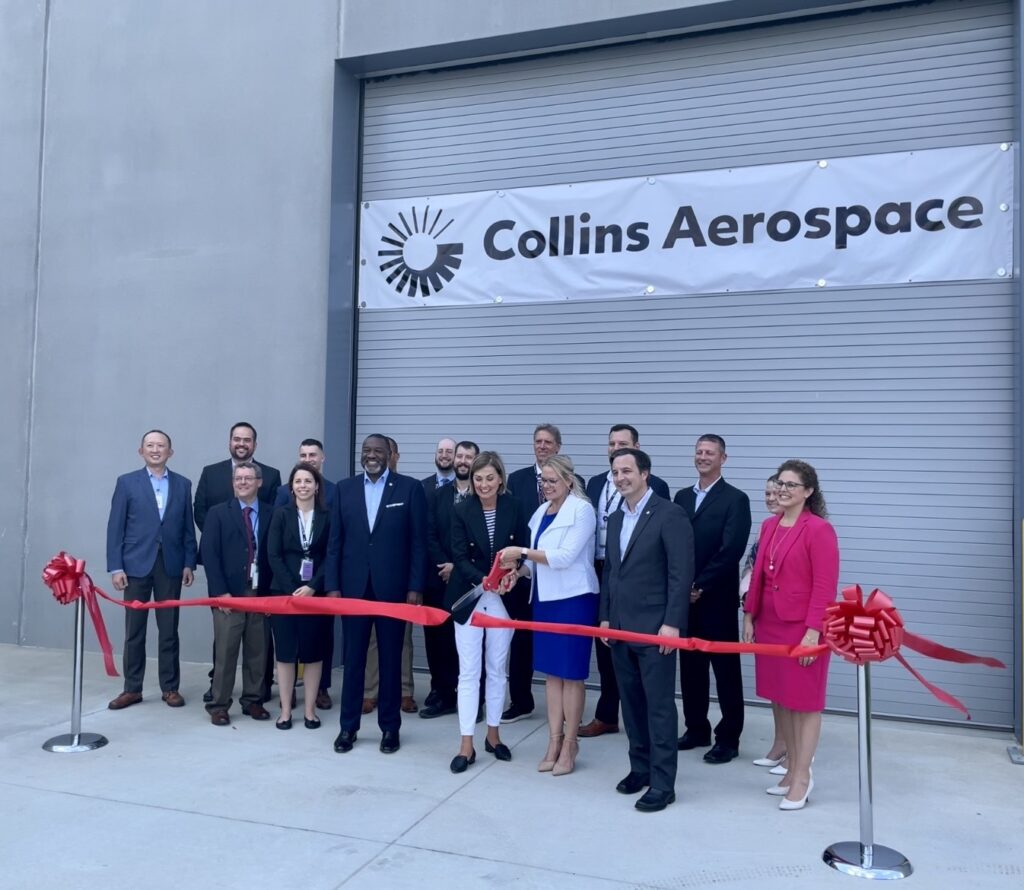
Collins Aerospace completed a $14 million expansion of its additive manufacturing facility in West Des Moines, Iowa. (Photos: Jessica Reed)
Last week, Collins Aerospace celebrated a 9,000-square-foot expansion of its additive manufacturing facility. The site is located in West Des Moines, Iowa. The $14 million expansion of the facility will enable the installation of multiple new 3D metal printers that promise to increase the additive manufacturing capabilities of Collins’ team.

The facility received its first additive manufacturing machine back in 2016 which was capable of producing objects smaller than roughly one cubic foot. The first of the new 3D metal printers, which has already been installed onsite, can produce parts that are eight times larger in volume. “It’s really meant for maximum production,” remarked a member of the Collins team during a tour of the facility.
“We’ve just finished working with the OEM to do site acceptance testing on the equipment,” they shared with Avionics. “That is now signed off, and we’re going to start working on process development—choosing parameters for the lasers, writing our specifications for aerospace, and getting ready to ramp up production. Working through that process will take about six months to a year.”

Of the roughly 40 employees at the West Des Moines facility, about 10 or 15 are working directly with additive manufacturing. Collins also has additive production centers in Iowa, Minnesota, North Carolina, and Singapore, as well as a research center for additive manufacturing in Connecticut.
The U.S. Air Force’s Arnold Engineering Development Complex (AEDC) hopes to leverage additive manufacturing for building parts of the Department of Defense’s hypersonic test facilities. Additive manufacturing involves building objects layer by layer. The process takes advantage of 3D modeling and advanced fiber materials.
Renee Begley, Collins’ West Des Moines site lead, commented on the announcement, saying: “From supporting the backlog in commercial aircraft to enabling future platforms, and reducing carbon emissions to providing supply chain relief, additive manufacturing is poised to play an integral role in the future of the aerospace and defense industry. Additive manufacturing has the potential to help us reduce weight, complexity, lead time, and cost in the parts we supply, and this expansion represents an investment in our business to help deliver those benefits to our customers.”
She remarked during a tour of the facility, “Additive manufacturing is a game changer for the entire aerospace and defense industry.”

PJ Titone, Vice President of Engine Control Systems at Collins Aerospace, shared a few words prior to the ribbon-cutting ceremony: “Power controls products make flying safer, quieter, and more comfortable. We are leading the development of more electric and autonomous solutions that will power the future aircraft of tomorrow.”

PJ Titone, Vice President of Engine Control Systems
Henry Brooks, President of Power & Controls, also spoke during Collins’ facility expansion event. “Additive is a key focus not only for this facility, but for Collins Aerospace, and for RTX as a company,” he said.
“This technology enables us to produce parts faster, at a lower cost, and with greater precision, to best support our strategic business units across Collins Aerospace, our commercial and our military OEMs, and airline partners.”

Henry Brooks, President of Power & Controls
“This really furthers RTX’s commitment to being a more sustainable company,” Brooks added. “The aerospace industry is not standing still; it is moving towards a net zero greenhouse emissions future. And when you think about what additive can do—less weight, better cost, lower risk, speed to market—we are right in the middle of what can make this market move a lot faster.”
“Even before today, this West Des Moines facility was a global powerhouse in fuel nozzles for the aerospace industry,” Governor Kim Reynolds said during the event. “Now with the addition of the 9,000 square feet of space for even more powerful 3D metal printers, you are poised to push production to get into it even higher gear.”
She added, “Manufacturing is Iowa’s largest industry sector, accounting for 19% of our GDP and 60% of our exports. But what’s even more important than the raw numbers is the culture of partnership, growth, and innovation that makes it all work.”

Kim Reynolds, Governor of Iowa